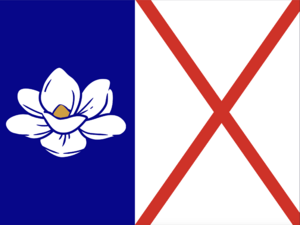Neuse
The Commonwealth of Neuse | |
|---|---|
|
Flag | |
| Motto: Without God, Nothing | |
| Anthem: Hymn of the Tidewater | |
| Status | Independent |
| Capital | Rodanthe |
| Largest | Edenton |
| Official languages | None |
| Recognised national languages | Marl'er, Wachauer |
| Recognised regional languages | Hill Speak, Tider, Taborite |
| Chicaroan Languages | Coree, Haw, Eno |
| Ethnic groups (2010) | |
| Religion (2010) | Sacramentalism, Roddanism, Calixtinism |
| Demonym(s) | Neusen/Neusean/Neusener |
| Government | Federal Semi-Presidential Republic |
• Governor | John R. Tryon |
• Lt. Governor | James Swan |
| Legislature | Rodanthe Assembly |
| Establishment | |
| January 22nd, 1997 | |
• Consitution Adopted | August 2nd, 1999 |
| Area | |
• | 1,628,973 km2 (628,950 sq mi) |
| Population | |
• 2010 estimate | 2,586,091 |
• 2010 census | 2,586,091 |
• Density | 1.59/km2 (4.1/sq mi) |
| Currency | Neusen Coren (NCN) |
The Commonwealth of Neuse, commonly called Neuse or the Commonwealth, is a minor multi-national state located in the south of Ardentia. It borders the _ Ocean to the South, _ Ocean to the West, and Nuevo Zancara to the north. It has a predominantly humid-subtropical climate, and an area of 628,950 square miles (1,628,973 square kilometers) with an incorporated population of 2,641,000. Neuse is comprised of two provinces and one unorganized territory. A multi-national state, Neuse is the union of the two formerly sovereign states Albemarle and Wachau, now the provinces of Albemarle and Wachovia respectively. It's capital is at Rodanthe and the largest city is Edenton.
The earliest known arrival of humans to the area of modern-day Neuse occured some 2,000 years ago by nomadic proto-Chicaroan peoples from the North, though evidence of permanent settlements does not exist until the 11th century AD. It was not until the 16th century that the first Neusen peoples arrived and settled the region east of the Great Divide. The arrival of the Neuseners caused a large displacement of the Chicaroans to the west of the Divide, where they now predominantly reside. Political leadership centralized during the late 18th century as the two distinct populations, the Marl'ers and the Wachauers, formed independent states. Conflict with the Chicaroan peoples over land and resources resulted in an informal alliance between the states of Wachau and Albemarle. By the late 20th century, political leaders from the two nations began talks that lead to the formation of the Commonwealth of Neuse. On January 22nd, 1997 the leaders of Wachau and Albemarle signed the Treaty of Waccamaw, formalizing the creation of The Commonwealth of Neuse.
Neuse is diplomatically isolated, and does not recognize any international treaties. Neuse has no official state language(s), however the functions of state are conducted primarily in Marl'er. Thanic religion is the predominant religion of Neuse, with Calixtinism and Sacramentalism representing the two largest sects. Neuse is technologically and economically underdeveloped, with a largely agrarian and un-industrialized economy.
Etymology
The exact origin of the name Neuse is unknown, however it is generally believed that the name Neuse is borrowed from the Neusiok Chicaroans who inhabited the lowlands at what is now the Tar Wash. Early settlers to the region record regular interactions with the Newiok, and written records from the time refer to the lands they occupied as "Niusok lands," "lands of the Neusok," and "the Neusi lands."
History
Main Article: History of Neuse
Chicaroan Peoples
The first inhabitants of what is now Neuse migrated south to the region from central Ardentia some 2,500 years ago. These proto-Chicaroans are believed to be the first Human culture to inhabit the region, 2,000 years ago. The Proto-Chicaroans lived a mostly nomadic existence; and over the next several hundred years proto-Chicaroan cultures grew increasingly sophisticated until the 11th century, when evidence of permanent settlement enters the archaeological record. The Gum Neck site marks the oldest site of permanent human settlement along the north fork of the Little Tabor River. From the 11th century to the 15th century the Chicaroans experienced a population boom and began to settle west of the Great Divide. Chicaroan society flourished, developing into the Eno, Yssa, Coree, Pahaw, Tocobaga, Loumbi, and Neusiok cultures. It is estimated that the Chicaroan population ranged from between 500,000 to 4 million prior to the arrival of the Neusen Peoples in the 16th century.
Neusen Settlement
Following the Great Exodus starting in 1577
